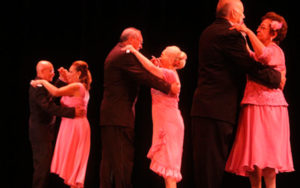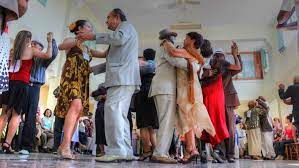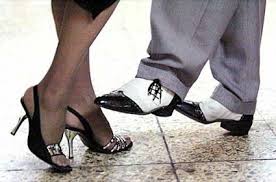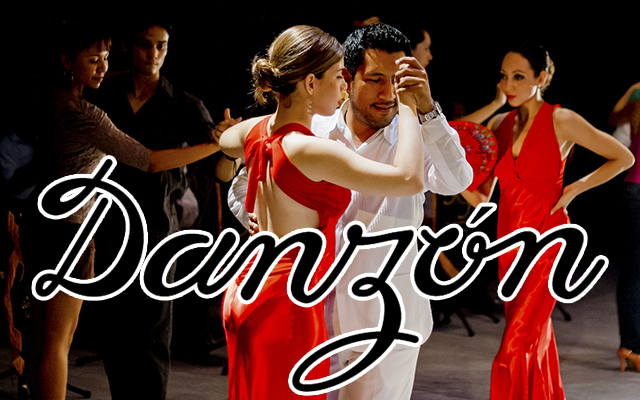
EL DANZON: “SI LA MUSICA ES LA VIDA, EL DANZON ES LA ALEGRIA”. MEXICO, SU SEGUNDA PATRIA. PHOTOS.
JULIA es una telefonista en Ciudad de México que divide su vida entre el trabajo, su hija y el danzón, un marco musical que constituye para ella parte de su todo. Cada miércoles, Julia se luce en la pista del “Salón Colonia” del brazo de Carmelo, su pareja de baile.
Cuando después de tres noches sin presentarse Carmelo desaparece, la mujer toma la determinación de ir a buscarlo a la ciudad de Veracruz, sin saber que ese viaje cambiará su vida en este pequeño resumen de la gestión fílmica de la productora mexicana María Novaro, que toma al sensual ritmo, el danzón, como armazón musical para destacar en su opinión un nuevo papel en la vida de la mujer mexicana y ese cadencioso ritmo que llegára a México hace 154 años para quedarse.
MEXICO Y CUBA
México tiene una vieja porfía con Cuba sobre la paternidad del danzón.
A diferencia de muchos ritmos y danzas caribeñas el danzón tiene una fecha de nacimiento: Matanzas, Cuba, enero 1, 1879, lugar y día en que el cubano Miguel Faílde debutó lo que se considera el primer danzón: “Las alturas de Simpson”.
Un año después entraba por el puerto de Progreso, Mérida, por Veracruz y Ciudad de México, desde donde prende a toda la República Mexicana.
Por mucho tiempo el danzón ha sido muy popular en el estado de Veracruz, en la costa del Golfo de México, debido a la fuerte influencia cubana en la región, más tarde, el danzón se desarrolló en la Ciudad de México, especialmente en el famoso Salón México; de hecho, ha sobrevivido como baile allí por más tiempo que en Cuba. El danzón también floreció en la ciudad de Oaxaca, y muchos danzones famosos fueron compuestos por músicos oaxaqueños, como las famosas Nereidas y Teléfono de larga distancia, ambas obras de Amador Pérez Dimas, del pueblo de Zaachila, cerca de la ciudad de Oaxaca.
LA MUJER MEXICANA EN JULIA
Como un suave y refinado instrumento de feminidad en su partitura original el danzón toma en la versión fílmica de la productora Novaro la promoción del popular género musical abriendo nuevamente en México el apetito rítmico de numerosos sitios para bailarlo e interpretarlo; aunque la vida de las mujeres de “danzón” gira alrededor de los hombres el filme se refiere más a los lazos que establecen ellas entre sí que a sus relaciones con los hombres mismos.
Para Julia, que considera bailar danzón la más destacada actividad de su vida, la búsqueda de Carmelo y su eventual encuentro con otros personajes del filme, le llevará de nueva cuenta a su feminidad que desmitifica los roles que comúnmente se les atribuyen a la mujer en México donde su papel ha adquirido enorme importancia acentuado con la producción de la película Danzón, el más femenino de todos los filmes mexicanos de todos los tiempos, según los críticos.
Con el regreso de Julia a su pueblo sin haber encontrado a su pareja, en Danzón la mujer cambia esa visión que prudentemente ve la separación de los cuerpos como lo estipulan las reglas originales del baile y con el regreso de Carmelo ese final encuentro de ambos cuerpos y el de una larga mirada que dejan al descubierto sus propios instintos y realidades.

EL PRIMER CONGRESO INTERNACIONAL DEL DANZON
Fue en los últimos días del mes de marzo de 2009 que se celebró en Ciudad de México, en la Plaza Tolsá y en La Ciudadela, lugares donde tradicionalmente se practica el baile, el I Congreso Internacional del Danzón, con la participación de bailarines, cineastas y especialistas originarios de Colombia, Cuba, Holanda, Italia, Venezuela, Guatemala y México. Espectáculo que terminó con una Gran Gala Danzonera en el Gran Forum (Metro Taxqueña) donde intervinieron Acerina y su Danzonera, Tres Generaciones, Dimas, Nueva Danzonera y otras conocidas orquestas e intérpretes del danzón.
Desde entonces se han celebrado imnumerables Congresos Internacional del Danzón en México, la otra patria del Danzon.
El danzón, género que indudablemente perdurará pese a nuestra época cargada de “escándalos” musicales, un ritmo que sobrevivirá a pesar de esa gigantesca oleada de tecnología y globalización.

EL DANZON: “IF MUSIC IS LIFE, THE DANZON IS JOY.” MEXICO ITS SECOND HOMELAND. PHOTOS.
JULIA is a telephone operator in Mexico City who divides her life between work, her daughter and the danzón, a musical framework that is part of everything for her. Every Wednesday, Julia shines on the dance floor of the “Salón Colonia” on the arm of Carmelo, her dance partner.
When Carmelo disappears after three nights without showing up, the woman decides to go look for him in the city of Veracruz, without knowing that this trip will change her life in this brief summary of the film management of the Mexican producer María Novaro, who uses the sensual rhythm, the danzón, as a musical framework to highlight, in her opinion, a new role in the life of the Mexican woman and that rhythmic rhythm that arrived in Mexico 154 years ago to stay.

MEXICO AND CUBA
Mexico has an old dispute with Cuba over the paternity of the danzón.
Unlike many Caribbean rhythms and dances, the danzón has a date of birth: Matanzas, Cuba, January 1, 1879, the place and day that the Cuban Miguel Faílde debuted what is considered the first danzón: “Las alturas de Simpson”.
A year later it entered through the port of Progreso, Mérida, through Veracruz and Mexico City, from where it caught on throughout the Mexican Republic.
For a long time the danzón has been very popular in the state of Veracruz, on the coast of the Gulf of Mexico, due to the strong Cuban influence in the region. Later, the danzón was developed in Mexico City, especially in the famous Salón México; in fact, it has survived as a dance there longer than in Cuba. The danzón also flourished in the city of Oaxaca, and many famous danzones were composed by Oaxacan musicians, such as the famous Nereidas and Teléfono de larga distancia, both works by Amador Pérez Dimas, from the town of Zaachila, near the city of Oaxaca.
THE MEXICAN WOMAN IN JULIA
As a soft and refined instrument of femininity in its original score, the danzón takes on the film version of the Novaro production company, promoting the popular musical genre, opening up again in Mexico the rhythmic appetite of numerous places to dance and interpret it; Although the lives of the women in “danzón” revolve around men, the film refers more to the ties they establish between themselves than to their relationships with the men themselves.
For Julia, who considers dancing danzón the most important activity of her life, the search for Carmelo and her eventual encounter with other characters in the film will lead her back to her femininity, which demystifies the roles commonly attributed to women in Mexico, where their role has acquired enormous importance, accentuated with the production of the film Danzón, the most feminine of all Mexican films of all time, according to critics.
With Julia’s return to her town without having found her partner, in Danzón the woman changes that vision that prudently sees the separation of the bodies as stipulated by the original rules of the dance, and with Carmelo’s return, that final encounter of both bodies and that of a long look that reveal their own instincts and realities.
THE FIRST INTERNATIONAL CONGRESS OF DANZON
It was in the last days of March 2009 that the First International Danzón Congress was held in Mexico City, in Plaza Tolsá and in La Ciudadela, places where the dance is traditionally practiced, with the participation of dancers, filmmakers and specialists from Colombia, Cuba, Holland, Italy, Venezuela, Guatemala and Mexico. The show ended with a Grand Danzon Gala in the Gran Forum (Metro Taxqueña) where Acerina and her Danzonera, Tres Generaciones, Dimas, Nueva Danzonera and other well-known danzón orchestras and performers performed.
Since then, countless International Danzón Congresses have been held in Mexico, the other homeland of Danzon.
Danzon, a genre that will undoubtedly endure despite our era full of musical “scandals,” a rhythm that will survive despite this gigantic wave of technology and globalization.

Agencies/ Arnoldo Varona/ Extractos/ Excerpts/ Internet Photos/ www.TheCubanHistory.com
THE CUBAN HISTORY/ LA HISTORIA DE CUBA.



